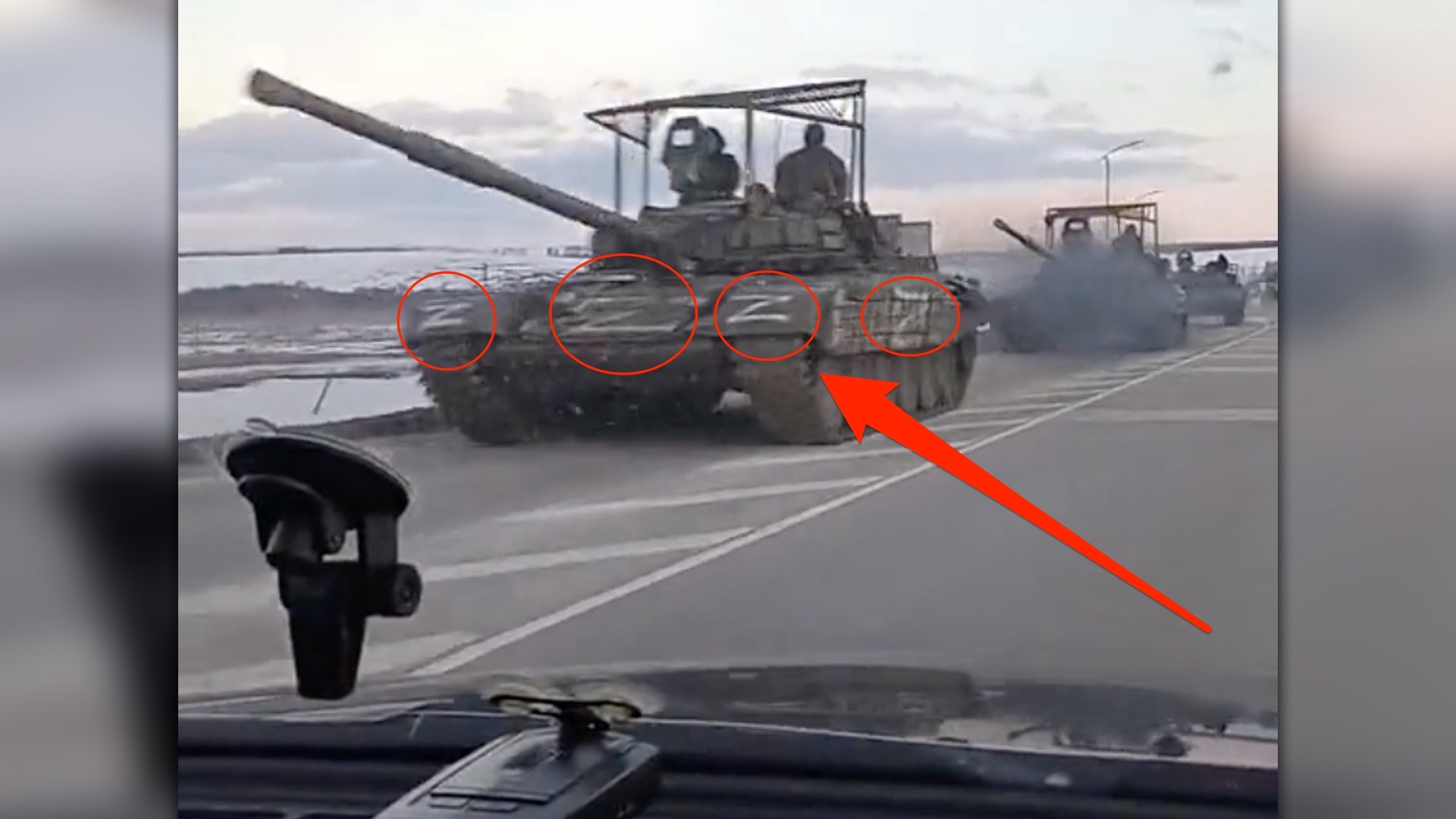

In the days leading up to Russia’s full-scale attack on Ukraine, several pictures and videos emerged on social media showing Russian tanks and other military equipment that appear to have the Latin letter “Z” painted on them in white.
Defense officials have not said publicly what the markings could mean. It is also worth noting that the letter “Z” does not exist in the Russian alphabet, so perhaps the symbol is a version of the Cyrillic letter “I.”
Defense experts believe could be a way for Russian forces to distinguish their troops from the Ukrainians. Both sides use very similar military equipment and in the smoke of battle, a Russian T-72 main battle tank may look a lot like a Ukrainian T-80 through long-range sights.
It is a common military practice to use such markings to distinguish friend from foe. The U.S. military painted black and white “invasion stripes” on its aircraft during the 1944 invasion of Normandy to prevent Allied troops landing on the beaches from inadvertently shooting at their own planes, and American forces painted an upside-down “V” on their vehicles as a recognition symbol during Operation Desert Storm, retired Marine Col. Mark Cancian, a senior adviser at the Center for Strategic and International Studies, told Task & Purpose.
“Bottom line is the ‘Z’ markings (and others like it) are a deconfliction measure to help prevent fratricide, or friendly fire incidents,” said Air Force Lt. Col. Tyson Wetzel, senior Air Force fellow with The Atlantic Council think tank in Washington, D.C. Because Russian warplanes, such as SU-25 Frogfoots and SU-34 Fullbacks, fly too quickly for their pilots to recognize the “Z” markings, these symbols are more likely meant to deter fratricide from Russian attack helicopters, artillery, rocket launchers, and mortars, Wetzel said.
But former Marine Capt. Rob Lee, who spent a year with a defense-focused think tank in Moscow, said he does not believe the “Z” markings are intended to prevent fratricide because they are relatively small and hard to see at a distance.
“They’re different from what you normally see on Russian vehicles,” said Lee, who is currently a Ph.D. candidate at The Department of War Studies at King’s College London. “They’re obviously something new. And the most likely reason they would have put these kinds of symbols on is to indicate a different task force, a different echelon.”
Lee noted that different versions of the markings have appeared in pictures, including the “Z” in a square, circle, or triangle — and some vehicles are marked solely with a triangle. Now that the invasion is underway, these different types of markings should allow Russian road guards directing traffic to make sure that a unit’s vehicles and equipment all go to the right place.
“These are markers that probably signify their task forces or different echelons so that they can keep things straight,” Lee said.
An unconfirmed rumor circulating on Russian social media is that Russian vehicles marked with the “Z’s” are intended to advance toward the Ukrainian city of Kharkiv, while columns bearing triangle markings could move west of the Donets Basin, he said.
Retired Army Lt. Gen. Ben Hodges, former commander of U.S. Army Europe, said that while he does not know what the “Z” markings mean, the 101st Airborne Division used symbols from playing cards to identify its four regiments during World War II. For example, soldiers with the 506th Parachute Infantry Regiment painted spades on their helmets.
If U.S. military leaders know what the “Z” markings mean, they are keeping that information to themselves. Scott Ghiringhelli, a spokesman for U.S. European Command, said command officials do not discuss intelligence and neither confirm nor speculate about military plans and operations.
When Task & Purpose asked the Pentagon about the markings, an unnamed spokesperson replied bluntly by email: “I refer you to the Government of Russia.” The Russian embassy in Washington, D.C., did not provide a comment for this story.
Update: This story was updated following Russia’s full-scale attack on Ukraine.
What’s hot on Task & Purpose
- Photos: What Russia’s invasion of Ukraine looks like on the ground
- Generation Z has a simple message when it comes to World War III: Please don’t draft me
- Army 3-star general suspended amid investigation into toxic climate and racist comments
- The best gear under $25 to make life in the field suck less, according to soldiers
Want to write for Task & Purpose? Click here. Or check out the latest stories on our homepage.
